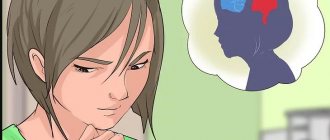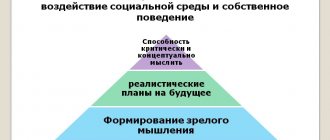Constancy as one of the characteristics of visual perception
Definition 2
The category of constancy is understood as relative stability, independence of the image from the conditions of its perception. Constancy is reflected in the fact that the size, shape, color, and magnitude of a physical object are perceived as constant, despite the fact that the signals coming from the analyzed objects are constantly changing
Finished works on a similar topic
- Coursework Visual perception 450 rub.
- Abstract Visual perception 280 rub.
- Test work Visual perception 200 rub.
Receive completed work or specialist advice on your educational project Find out the cost
The constancy of perception is ensured by the active actions of the perceptual system.
It is difficult to overestimate the importance of this quality of perception: in the absence of this property, with the slightest movement, changes in the distance to the object, with every turn of the head, changes in lighting, all the main signs of the object in the surrounding socio-natural environment, the surrounding reality itself, would constantly change, which would significantly complicate the process knowledge of objective reality would complicate the orientation of the individual in the surrounding world.
Psychology of visual perception. Notes on the margins of Match-3. Part 1.
Over the 12 years of its existence, Playrix has released many casual PC games of various genres, but match-3 has always remained the main one among them. Since 2011, the company switched to developing mobile free-to-play applications. This led to a rethinking of many work processes, including graphics.
There is a common opinion among game industry artists that working on match-3 projects is not so interesting and too easy. But in reality, creating match-3 graphics, in addition to artistic skills, requires remarkable design flair, and therefore knowledge of the psychology of perception. In this article we will share the accumulated experience from this area, supported by the success of our games.
The emphasis on the psychology of perception is not accidental, since this is a source of knowledge without the overlay of subjectivity. It helps to understand the most complex and controversial issues that arise during the development process. This article will consider three problems that arise from one another.
1. Graphic overload of levels.
Due to the focus on endless gameplay, it becomes more difficult to achieve good visual results when adding new game elements. On the one hand, they need to be included in the finished visual series, maintaining graphic integrity. On the other hand, the game object at later levels carries the most important semantic load - to stimulate interest in continuing the game and evoke a greater emotional response. As a result, game levels can become visually cluttered.
2. Conventional vs. Imagery.
This problem is connected with one of the most important principles of composition - ensuring the artistic integrity of the project, the unity of the whole and parts. When searching for new artistic techniques, the image of a game object is often conveyed conditionally, and this confuses the artist. For example, we have to combine linear perspective and axonometry, a 3D object and vector graphics on the playing field at the same time. The artist sees this as a violation of integrity, but the game designer insists on abstraction. And here a third problem arises in parallel.
3. Subjectivity of perception.
It is as old as the world, which everyone sees in their own way. How many people, so many opinions. It can be very difficult to convince someone that you are right. This results in long discussions, doubts and uncertainty that slow down the development process.
So, the three problems that will be considered here are outlined.
Solution to problem 1.
The main difference between free-to-play match-3 games and classic downloadable ones for PC is their focus on endless gameplay. For example, 25 new levels are added to our Fishdom project every week. And at the moment there are already 1500 of these levels.
Previously, for games on PC, we could afford to create several sets of tiles within one game, changing them from level to level and thus making the visuals more diverse. Other game elements (bonuses, blocking elements, etc.) remained constant throughout the game.
With the free-to-play model, everything has changed the other way around. The set of chips became strictly fixed with a constant set of six chips, and there were much more game elements. This is where we encountered the problem of graphical overload. Let's try to figure it out.
The attention span of adults usually ranges from 4 to 6 objects. For example, in chess there are only 6 pieces and 2 colors. There are also 6 chips in the game, but they are all individual not only in shape, but also in color. In addition, a number of other game elements are added.
Due to the infinity-oriented nature of the gameplay, the number of elements and combinations of them becomes so large that it is impossible to keep them in the attention zone
it gets difficult. At later levels there can be more than 10 different combinations of elements on the field at the same time.
In the screenshot below we see the beginning of the level. This organized structure of game elements is not accidental. It allows the player to see groups
objects and remember them. During the game, this clear structure very quickly collapses, turning into chaos.
The artist faces an extremely important task: to select for each game element such an artistic technique that would provide the viewer with an easy and quick
dividing this mass of objects into separate groups, focusing on visual characteristics.
A good example of when our brain’s ability to combine elements into groups, based on the principle of similarity
by shape, color, material, relative position “above” and “below”, image, etc.
On this topic in the psychology of image perception, there are rules for grouping based on the principle of similarity
. The example below is just a few of them.
If you look at the atlas of game objects from the game Fishdom, where only some of them are located, you can very easily divide them into separate groups.
For example:
- main 6 chips;
- elements that fill the entire field cell and repeat its shape - a square (stone, boards, tiles);
- forming a continuous mass without visible division into cells (earth, oil);
- locked elements inside square ones;
- objects placed on top of chips (ice, chains);
- objects occupying an area of more than 1 cell (iceberg, geyser);
- a living animated character, if the entire environment is objective (squids);
- achromatic objects (tires), etc.
Also, to enhance the character of game elements, animation, effects, and sound are additionally used.
The result is a harmonious system of groups of objects, where some features are more generalized, some more accentuated. The latter is important for the emotional response of the player, for example, the mole from Gardenscapes. This animated character crawls out of a hole, grabs nearby chips and hides back into the hole.
At first glance, it seems that ensuring division into groups is quite simple. But when elements appear that are identical in mass to chips, everything becomes not so clear-cut. For example, at the very beginning of developing the concept of game elements, the first thing they look for is the image of chips with bonuses. The main task is to make chips and bonuses distinguishable.
If you look at the game elements above, it is almost impossible to isolate any separate group from them.
What visual techniques can we use to provide the required condition? There is one important point here. A small phone monitor deprives us of the ability to use complex silhouettes, designs, color schemes, and noisy textures. We find ourselves in a situation of severe limitation with high demands. In addition, objects of the same mass should be clearly distinguishable from each other and should not create the illusion of similarity or group together. Therefore, every fine art discovery is worth its weight in gold. We will tell you about one of them now.
Three spaces of the picture plane
Once on the Sky Charms project, our development team encountered such a situation. The graphic content for match-3 was almost ready. The polishing stage was underway. At some point, the chips began to lose to other game elements. They looked flat compared to their surroundings. And the work began to boil: long discussions and analysis, edits and adjustments.
And when everything was ready, during the test it turned out that it was easier to play with flat chips. Volumetric ones cause visual strain. And no matter how morally difficult it was to abandon the work done, the final chips went to the finals.
A year later, a similar situation was repeated on another project - Gardenscapes. In the same way, at the polishing stage, we gave the chips more volume. And in the same way, the “improved” result during the test made a controversial impression (see screenshot below, on the left - the version before edits. on the right - after edits)
The second case is a signal for serious analysis and search for the real reasons. Ultimately, the answer was found in Alexander Lapin’s book “Plane and Space.”
Our brain is amazingly capable of creating the illusion of space on a plane with an image. But where is this space?
If you compare a picture from a cartoon by H. Miyazaki and a dark disk on a white background, the illusion is that the road leading into a shady forest is behind the screen plane. The disc projects towards the viewer. The illusion of "protrusion" is so active that the disk does not simply lie on top of the plane. He really protrudes into the viewer's space.
Lapin, in his book, provides dozens of pages of mathematical calculations (!), proving and clarifying how strongly the disk is separated from the background plane under various conditions. There is a very interesting example in the book with Malevich’s square: the illusion of protrusion when viewing a painting from a distance of 10 meters is such that a person can squeeze between the square and the painting.
Thus, we have three spaces: behind the screen, the screen itself held by the device format, and the space in front of the screen plane.
The use of this phenomenon of separation of plans going deeper or protruding into the viewer’s space is very actively used in advertising, animation, and interface design. Here it is very important to clarify the moment under what circumstances an object can “protrude” and under what circumstances it retreats behind the screen. Let’s see how tonality and line affect spatiality.
The sphere and cube, which have a classic chiaroscuro design, undoubtedly belong to the space behind the screen. When simplifying the volume diagram, it is clearly visible that the cube retains its spatiality. While the sphere is more like a convexity and clearly protrudes into the viewer’s space. In the linear version, the cube still creates the illusion of space, unlike a circle.
The constructive method is the most powerful of all methods that create the illusion of space. However, an object in an orthogonal projection (and a sphere in any angle will have the silhouette of a circle) with a conditionally defined volume will protrude above the screen plane.
That’s why half-volume chips were easier to read than those with a pronounced volume! The perceptual protrusion of the chips into the space above the monitor was an additional factor in grouping according to the principle of similarity relative to other larger objects on the playing field.
In order for the chips to “protrude” into the viewer’s space, they must be:
- simple and round in silhouette;
- have an orthogonal frontal projection without visible structural edges, such as a cube or cylinder;
- a small soft color range of the gradient that will not split the shape;
- fixing stroke;
- and preferably a narrow focus of the image. Lollipops, fruits, cubes, flowers, etc.
This will ensure easy identification of a group of chips among other groups of game elements. This conclusion is not a rule, but only one of the solutions found. Chips can be three-dimensional, spatially oriented as opposed to, say, more conventional game elements. Beautiful three-dimensional pieces that fit harmoniously into the gaming space are the dream of any artist who has worked on a match-3 project.
In the second part we will look at the second problem associated with the painful search for harmonious solutions between convention and imagery, and also touch on the topic of subjectivity of perception.
Objectivity as an essential characteristic of visual perception
Definition 3
The category of objectivity is reflected in the fact that the object is perceived as isolated in space, a separate physical body.
The human brain divides the information from the surrounding reality coming from the perceptual system into two unequal parts: the background, which is perceived as an amorphous, unlimited, indefinite field, and the object - a clearly defined, concrete whole located in the foreground.
Too lazy to read?
Ask a question to the experts and get an answer within 15 minutes!
Ask a Question
The clarity of highlighting an individual object is largely due to contrast. In the absence of pronounced contrast, the physical object merges with the background, which significantly complicates the processes of its cognition.
There are two types of contrast: direct, in which the object is darker than the background, and reverse, in which the object is perceived as brighter than the background.
The concept of visualization in psychology, who is the founder of the technique?
Visualization is a tool that helps create correct and realistic mental images. There are many different visualization techniques used in psychology today, each designed based on a person's purpose and need.
The concept of visualization was first introduced by psychiatrist Carl Jung; he also developed the first visualization technique - active imagination, a method of working with subjective images in order to have a positive effect on consciousness.









